BBS102/BHM102/BAC102 Cloud Computing: ICT Advancement Research
VerifiedAdded on 2023/06/07
|10
|2298
|203
Report
AI Summary
This research report examines cloud computing as a significant advancement in ICT, focusing on its benefits and challenges within the business environment. It reviews literature highlighting cloud computing's evolution from grid computing and its diverse applications, including data storage, mobile app design, and healthcare. The report details the advantages of cloud adoption, such as reduced IT costs, increased flexibility, enhanced business continuity, and improved collaboration, while also addressing concerns like security breaches, resource shortages, cost management, and performance dependence on service providers. A case study of Komatsu Australia illustrates the practical benefits of cloud computing in reducing IT costs and improving operational efficiency. The report concludes with recommendations for future research, enhanced security measures, and proactive monitoring of cloud infrastructure to ensure data protection and reliable service delivery.
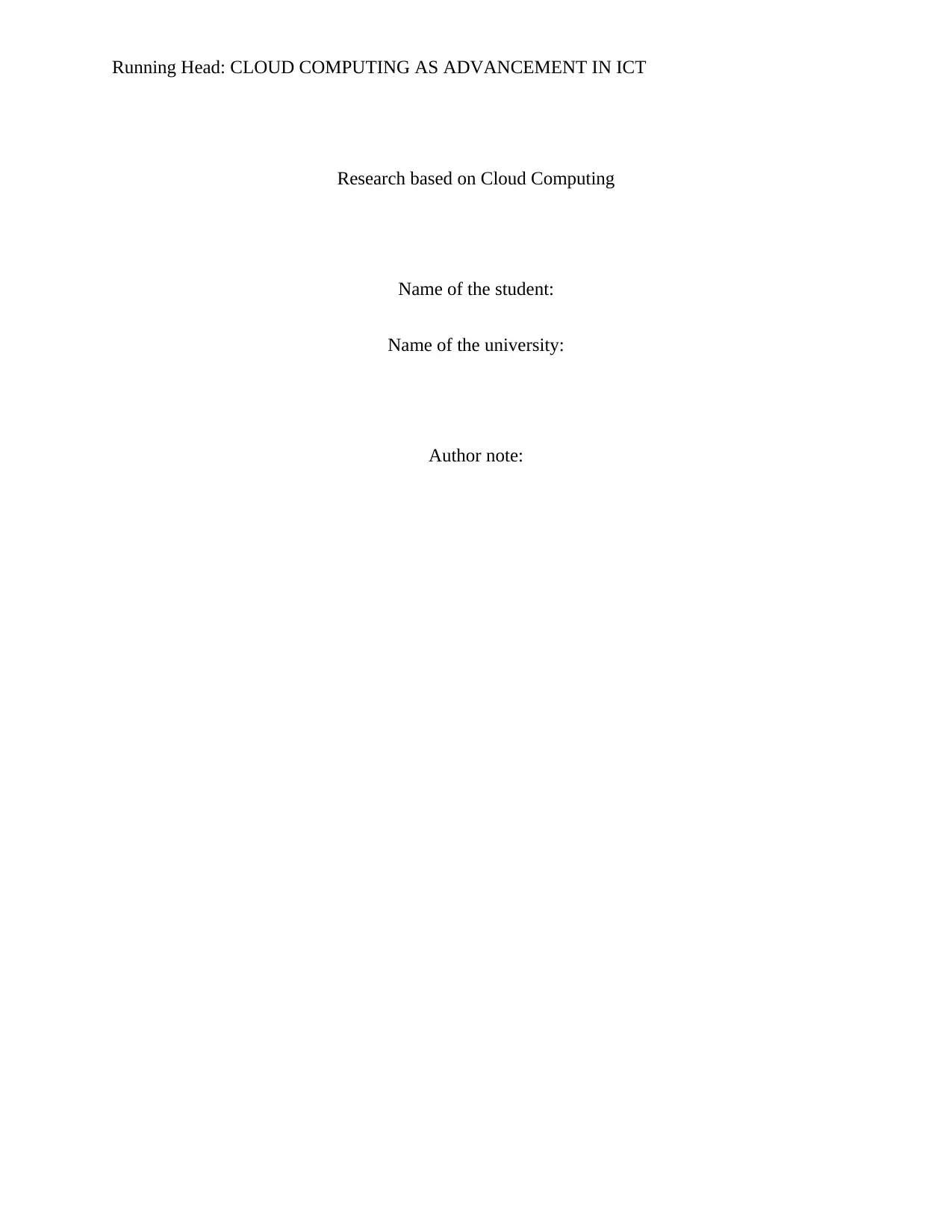
Running Head: CLOUD COMPUTING AS ADVANCEMENT IN ICT
Research based on Cloud Computing
Name of the student:
Name of the university:
Author note:
Research based on Cloud Computing
Name of the student:
Name of the university:
Author note:
Paraphrase This Document
Need a fresh take? Get an instant paraphrase of this document with our AI Paraphraser
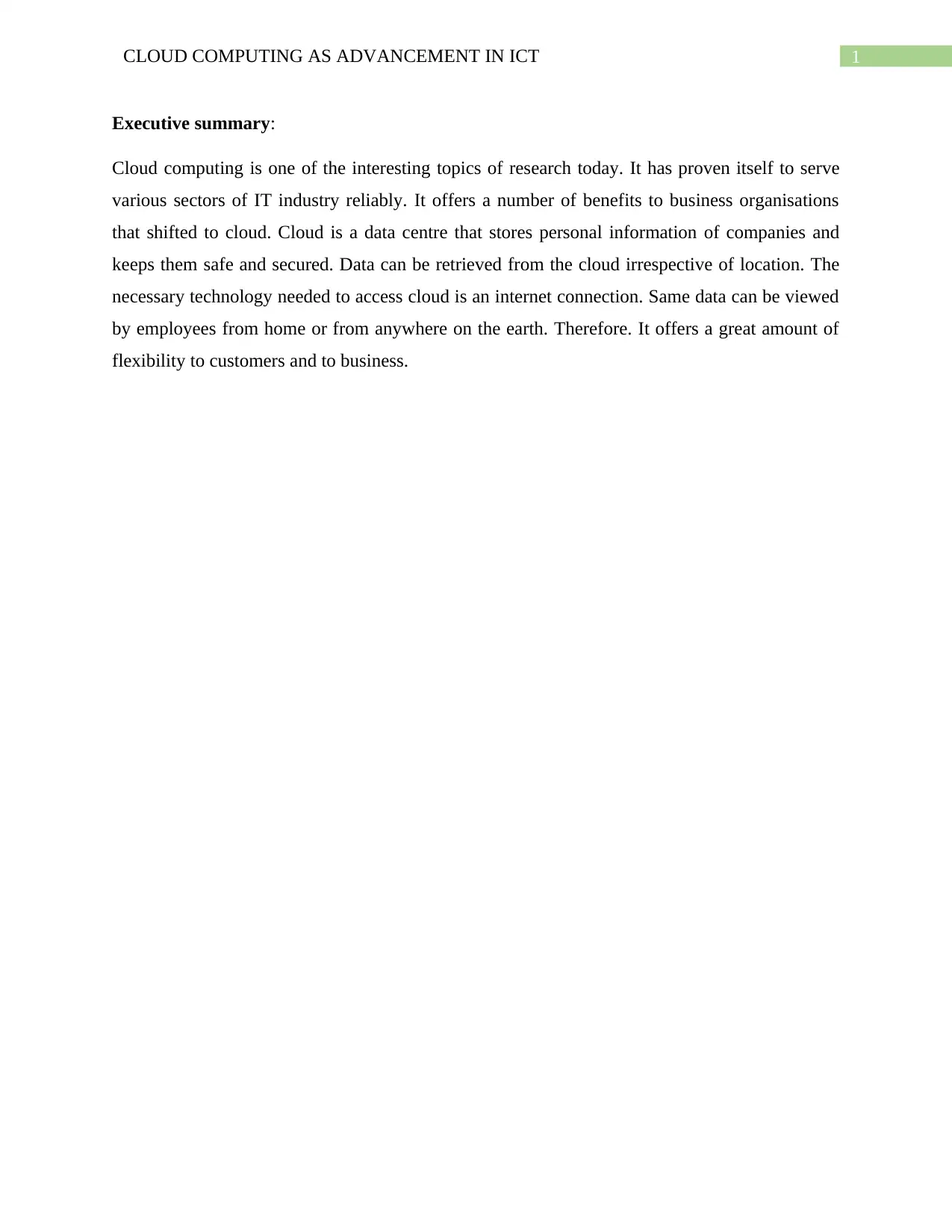
1CLOUD COMPUTING AS ADVANCEMENT IN ICT
Executive summary:
Cloud computing is one of the interesting topics of research today. It has proven itself to serve
various sectors of IT industry reliably. It offers a number of benefits to business organisations
that shifted to cloud. Cloud is a data centre that stores personal information of companies and
keeps them safe and secured. Data can be retrieved from the cloud irrespective of location. The
necessary technology needed to access cloud is an internet connection. Same data can be viewed
by employees from home or from anywhere on the earth. Therefore. It offers a great amount of
flexibility to customers and to business.
Executive summary:
Cloud computing is one of the interesting topics of research today. It has proven itself to serve
various sectors of IT industry reliably. It offers a number of benefits to business organisations
that shifted to cloud. Cloud is a data centre that stores personal information of companies and
keeps them safe and secured. Data can be retrieved from the cloud irrespective of location. The
necessary technology needed to access cloud is an internet connection. Same data can be viewed
by employees from home or from anywhere on the earth. Therefore. It offers a great amount of
flexibility to customers and to business.
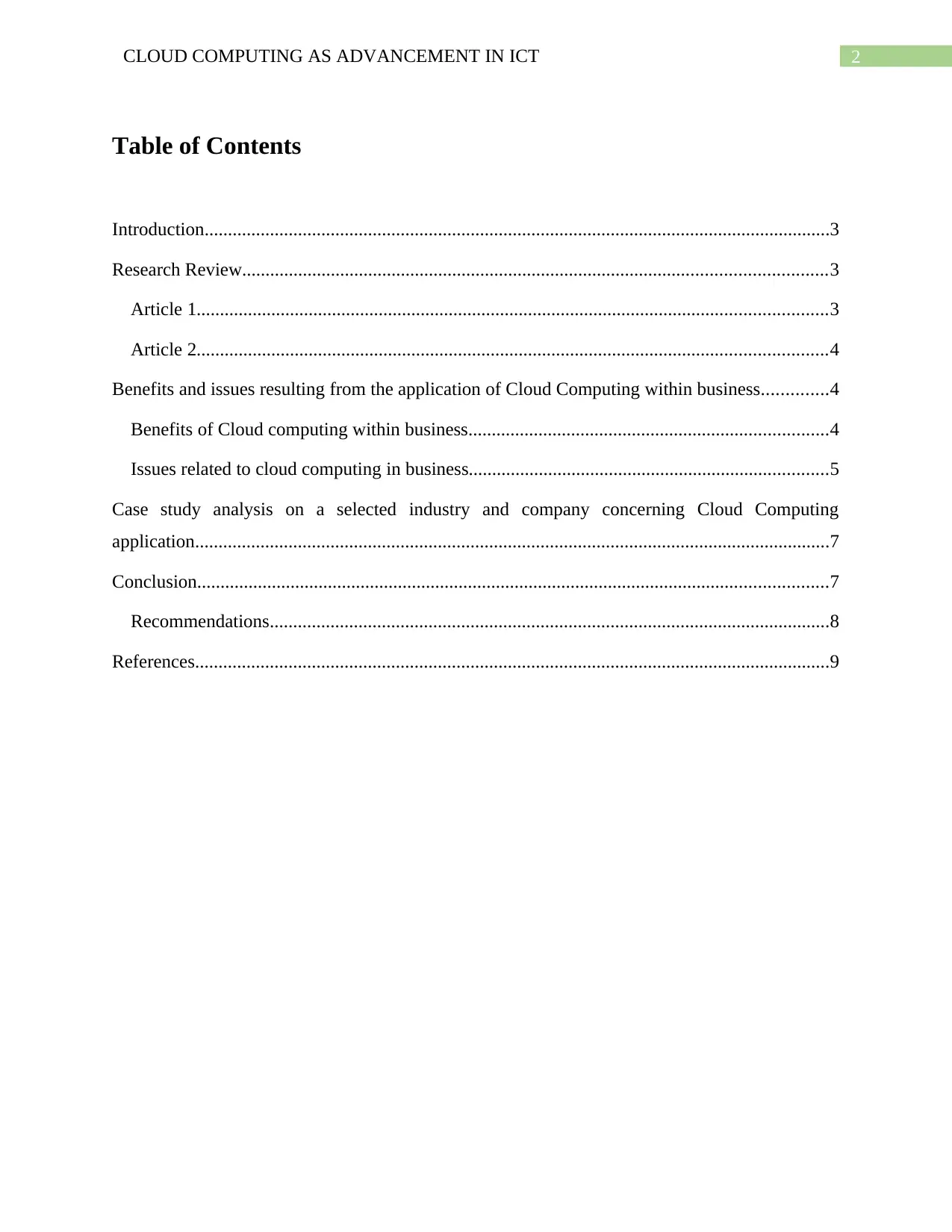
2CLOUD COMPUTING AS ADVANCEMENT IN ICT
Table of Contents
Introduction......................................................................................................................................3
Research Review.............................................................................................................................3
Article 1.......................................................................................................................................3
Article 2.......................................................................................................................................4
Benefits and issues resulting from the application of Cloud Computing within business..............4
Benefits of Cloud computing within business.............................................................................4
Issues related to cloud computing in business.............................................................................5
Case study analysis on a selected industry and company concerning Cloud Computing
application........................................................................................................................................7
Conclusion.......................................................................................................................................7
Recommendations........................................................................................................................8
References........................................................................................................................................9
Table of Contents
Introduction......................................................................................................................................3
Research Review.............................................................................................................................3
Article 1.......................................................................................................................................3
Article 2.......................................................................................................................................4
Benefits and issues resulting from the application of Cloud Computing within business..............4
Benefits of Cloud computing within business.............................................................................4
Issues related to cloud computing in business.............................................................................5
Case study analysis on a selected industry and company concerning Cloud Computing
application........................................................................................................................................7
Conclusion.......................................................................................................................................7
Recommendations........................................................................................................................8
References........................................................................................................................................9
⊘ This is a preview!⊘
Do you want full access?
Subscribe today to unlock all pages.

Trusted by 1+ million students worldwide
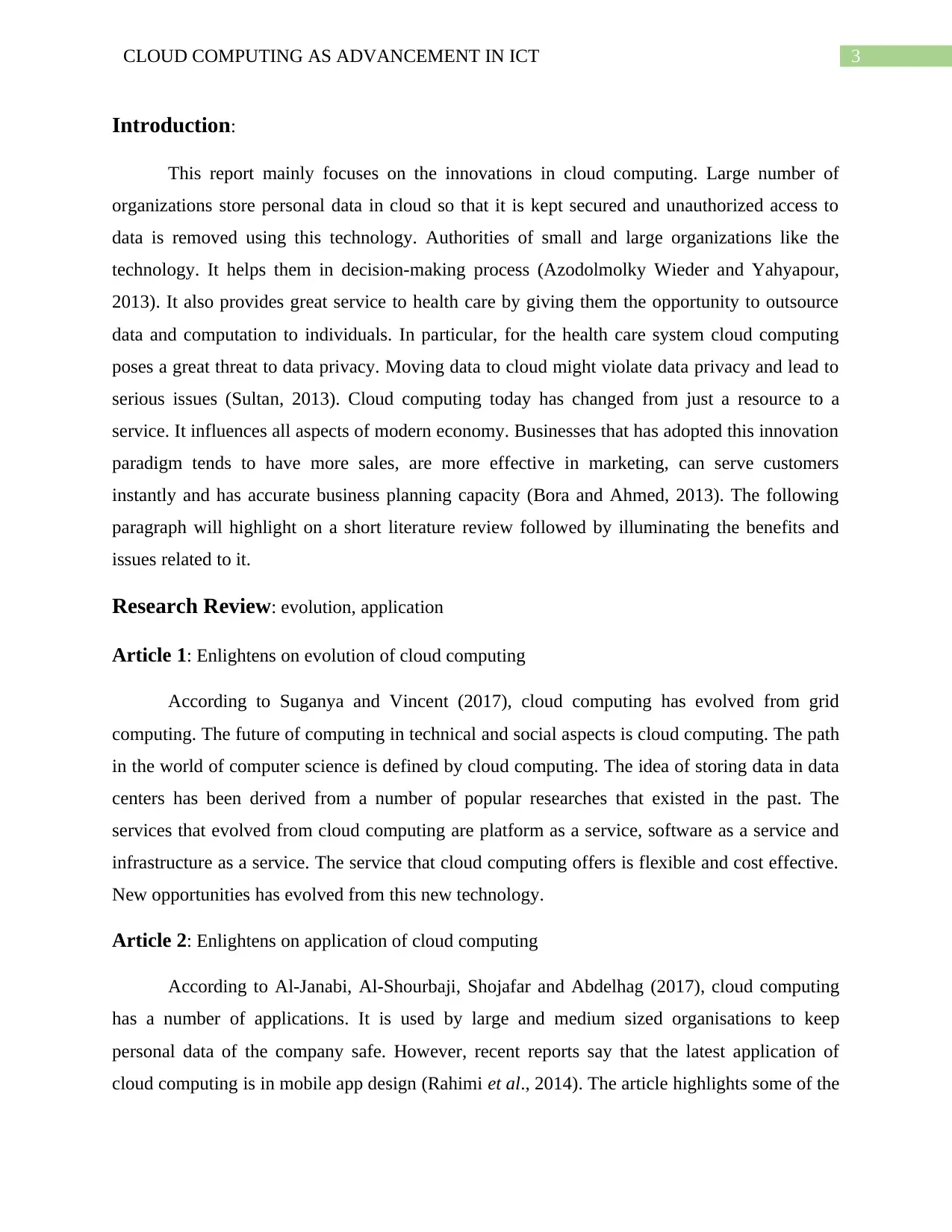
3CLOUD COMPUTING AS ADVANCEMENT IN ICT
Introduction:
This report mainly focuses on the innovations in cloud computing. Large number of
organizations store personal data in cloud so that it is kept secured and unauthorized access to
data is removed using this technology. Authorities of small and large organizations like the
technology. It helps them in decision-making process (Azodolmolky Wieder and Yahyapour,
2013). It also provides great service to health care by giving them the opportunity to outsource
data and computation to individuals. In particular, for the health care system cloud computing
poses a great threat to data privacy. Moving data to cloud might violate data privacy and lead to
serious issues (Sultan, 2013). Cloud computing today has changed from just a resource to a
service. It influences all aspects of modern economy. Businesses that has adopted this innovation
paradigm tends to have more sales, are more effective in marketing, can serve customers
instantly and has accurate business planning capacity (Bora and Ahmed, 2013). The following
paragraph will highlight on a short literature review followed by illuminating the benefits and
issues related to it.
Research Review: evolution, application
Article 1: Enlightens on evolution of cloud computing
According to Suganya and Vincent (2017), cloud computing has evolved from grid
computing. The future of computing in technical and social aspects is cloud computing. The path
in the world of computer science is defined by cloud computing. The idea of storing data in data
centers has been derived from a number of popular researches that existed in the past. The
services that evolved from cloud computing are platform as a service, software as a service and
infrastructure as a service. The service that cloud computing offers is flexible and cost effective.
New opportunities has evolved from this new technology.
Article 2: Enlightens on application of cloud computing
According to Al-Janabi, Al-Shourbaji, Shojafar and Abdelhag (2017), cloud computing
has a number of applications. It is used by large and medium sized organisations to keep
personal data of the company safe. However, recent reports say that the latest application of
cloud computing is in mobile app design (Rahimi et al., 2014). The article highlights some of the
Introduction:
This report mainly focuses on the innovations in cloud computing. Large number of
organizations store personal data in cloud so that it is kept secured and unauthorized access to
data is removed using this technology. Authorities of small and large organizations like the
technology. It helps them in decision-making process (Azodolmolky Wieder and Yahyapour,
2013). It also provides great service to health care by giving them the opportunity to outsource
data and computation to individuals. In particular, for the health care system cloud computing
poses a great threat to data privacy. Moving data to cloud might violate data privacy and lead to
serious issues (Sultan, 2013). Cloud computing today has changed from just a resource to a
service. It influences all aspects of modern economy. Businesses that has adopted this innovation
paradigm tends to have more sales, are more effective in marketing, can serve customers
instantly and has accurate business planning capacity (Bora and Ahmed, 2013). The following
paragraph will highlight on a short literature review followed by illuminating the benefits and
issues related to it.
Research Review: evolution, application
Article 1: Enlightens on evolution of cloud computing
According to Suganya and Vincent (2017), cloud computing has evolved from grid
computing. The future of computing in technical and social aspects is cloud computing. The path
in the world of computer science is defined by cloud computing. The idea of storing data in data
centers has been derived from a number of popular researches that existed in the past. The
services that evolved from cloud computing are platform as a service, software as a service and
infrastructure as a service. The service that cloud computing offers is flexible and cost effective.
New opportunities has evolved from this new technology.
Article 2: Enlightens on application of cloud computing
According to Al-Janabi, Al-Shourbaji, Shojafar and Abdelhag (2017), cloud computing
has a number of applications. It is used by large and medium sized organisations to keep
personal data of the company safe. However, recent reports say that the latest application of
cloud computing is in mobile app design (Rahimi et al., 2014). The article highlights some of the
Paraphrase This Document
Need a fresh take? Get an instant paraphrase of this document with our AI Paraphraser
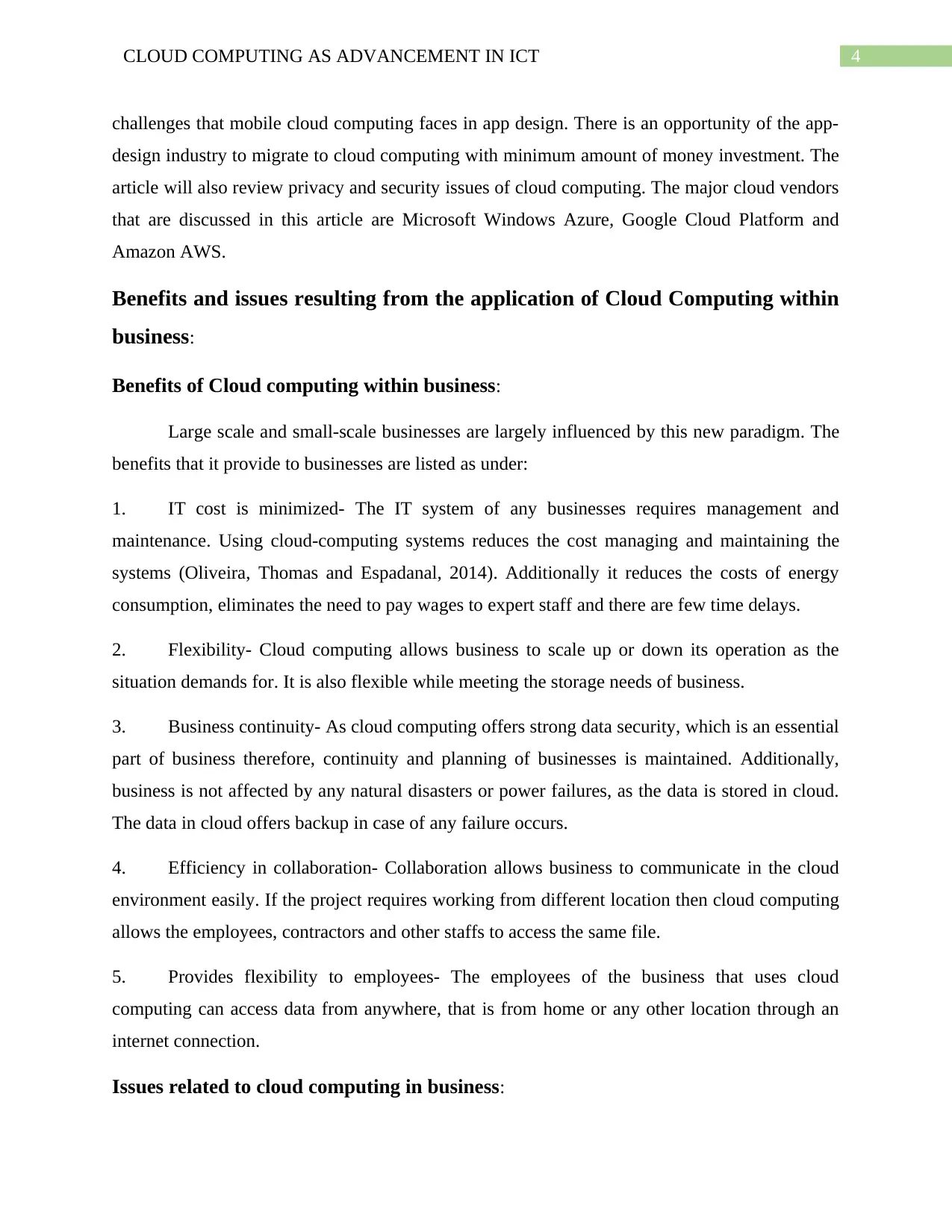
4CLOUD COMPUTING AS ADVANCEMENT IN ICT
challenges that mobile cloud computing faces in app design. There is an opportunity of the app-
design industry to migrate to cloud computing with minimum amount of money investment. The
article will also review privacy and security issues of cloud computing. The major cloud vendors
that are discussed in this article are Microsoft Windows Azure, Google Cloud Platform and
Amazon AWS.
Benefits and issues resulting from the application of Cloud Computing within
business:
Benefits of Cloud computing within business:
Large scale and small-scale businesses are largely influenced by this new paradigm. The
benefits that it provide to businesses are listed as under:
1. IT cost is minimized- The IT system of any businesses requires management and
maintenance. Using cloud-computing systems reduces the cost managing and maintaining the
systems (Oliveira, Thomas and Espadanal, 2014). Additionally it reduces the costs of energy
consumption, eliminates the need to pay wages to expert staff and there are few time delays.
2. Flexibility- Cloud computing allows business to scale up or down its operation as the
situation demands for. It is also flexible while meeting the storage needs of business.
3. Business continuity- As cloud computing offers strong data security, which is an essential
part of business therefore, continuity and planning of businesses is maintained. Additionally,
business is not affected by any natural disasters or power failures, as the data is stored in cloud.
The data in cloud offers backup in case of any failure occurs.
4. Efficiency in collaboration- Collaboration allows business to communicate in the cloud
environment easily. If the project requires working from different location then cloud computing
allows the employees, contractors and other staffs to access the same file.
5. Provides flexibility to employees- The employees of the business that uses cloud
computing can access data from anywhere, that is from home or any other location through an
internet connection.
Issues related to cloud computing in business:
challenges that mobile cloud computing faces in app design. There is an opportunity of the app-
design industry to migrate to cloud computing with minimum amount of money investment. The
article will also review privacy and security issues of cloud computing. The major cloud vendors
that are discussed in this article are Microsoft Windows Azure, Google Cloud Platform and
Amazon AWS.
Benefits and issues resulting from the application of Cloud Computing within
business:
Benefits of Cloud computing within business:
Large scale and small-scale businesses are largely influenced by this new paradigm. The
benefits that it provide to businesses are listed as under:
1. IT cost is minimized- The IT system of any businesses requires management and
maintenance. Using cloud-computing systems reduces the cost managing and maintaining the
systems (Oliveira, Thomas and Espadanal, 2014). Additionally it reduces the costs of energy
consumption, eliminates the need to pay wages to expert staff and there are few time delays.
2. Flexibility- Cloud computing allows business to scale up or down its operation as the
situation demands for. It is also flexible while meeting the storage needs of business.
3. Business continuity- As cloud computing offers strong data security, which is an essential
part of business therefore, continuity and planning of businesses is maintained. Additionally,
business is not affected by any natural disasters or power failures, as the data is stored in cloud.
The data in cloud offers backup in case of any failure occurs.
4. Efficiency in collaboration- Collaboration allows business to communicate in the cloud
environment easily. If the project requires working from different location then cloud computing
allows the employees, contractors and other staffs to access the same file.
5. Provides flexibility to employees- The employees of the business that uses cloud
computing can access data from anywhere, that is from home or any other location through an
internet connection.
Issues related to cloud computing in business:
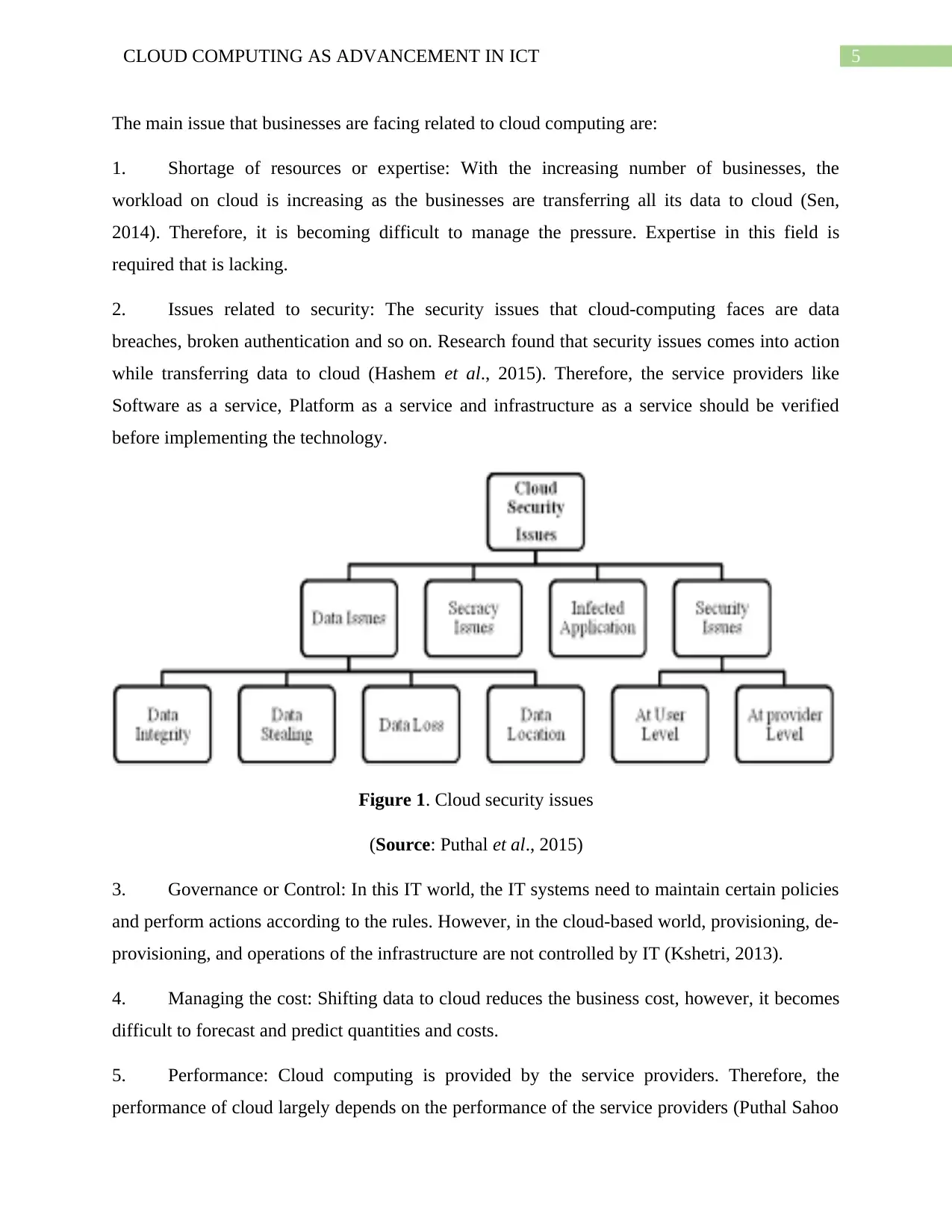
5CLOUD COMPUTING AS ADVANCEMENT IN ICT
The main issue that businesses are facing related to cloud computing are:
1. Shortage of resources or expertise: With the increasing number of businesses, the
workload on cloud is increasing as the businesses are transferring all its data to cloud (Sen,
2014). Therefore, it is becoming difficult to manage the pressure. Expertise in this field is
required that is lacking.
2. Issues related to security: The security issues that cloud-computing faces are data
breaches, broken authentication and so on. Research found that security issues comes into action
while transferring data to cloud (Hashem et al., 2015). Therefore, the service providers like
Software as a service, Platform as a service and infrastructure as a service should be verified
before implementing the technology.
Figure 1. Cloud security issues
(Source: Puthal et al., 2015)
3. Governance or Control: In this IT world, the IT systems need to maintain certain policies
and perform actions according to the rules. However, in the cloud-based world, provisioning, de-
provisioning, and operations of the infrastructure are not controlled by IT (Kshetri, 2013).
4. Managing the cost: Shifting data to cloud reduces the business cost, however, it becomes
difficult to forecast and predict quantities and costs.
5. Performance: Cloud computing is provided by the service providers. Therefore, the
performance of cloud largely depends on the performance of the service providers (Puthal Sahoo
The main issue that businesses are facing related to cloud computing are:
1. Shortage of resources or expertise: With the increasing number of businesses, the
workload on cloud is increasing as the businesses are transferring all its data to cloud (Sen,
2014). Therefore, it is becoming difficult to manage the pressure. Expertise in this field is
required that is lacking.
2. Issues related to security: The security issues that cloud-computing faces are data
breaches, broken authentication and so on. Research found that security issues comes into action
while transferring data to cloud (Hashem et al., 2015). Therefore, the service providers like
Software as a service, Platform as a service and infrastructure as a service should be verified
before implementing the technology.
Figure 1. Cloud security issues
(Source: Puthal et al., 2015)
3. Governance or Control: In this IT world, the IT systems need to maintain certain policies
and perform actions according to the rules. However, in the cloud-based world, provisioning, de-
provisioning, and operations of the infrastructure are not controlled by IT (Kshetri, 2013).
4. Managing the cost: Shifting data to cloud reduces the business cost, however, it becomes
difficult to forecast and predict quantities and costs.
5. Performance: Cloud computing is provided by the service providers. Therefore, the
performance of cloud largely depends on the performance of the service providers (Puthal Sahoo
⊘ This is a preview!⊘
Do you want full access?
Subscribe today to unlock all pages.

Trusted by 1+ million students worldwide
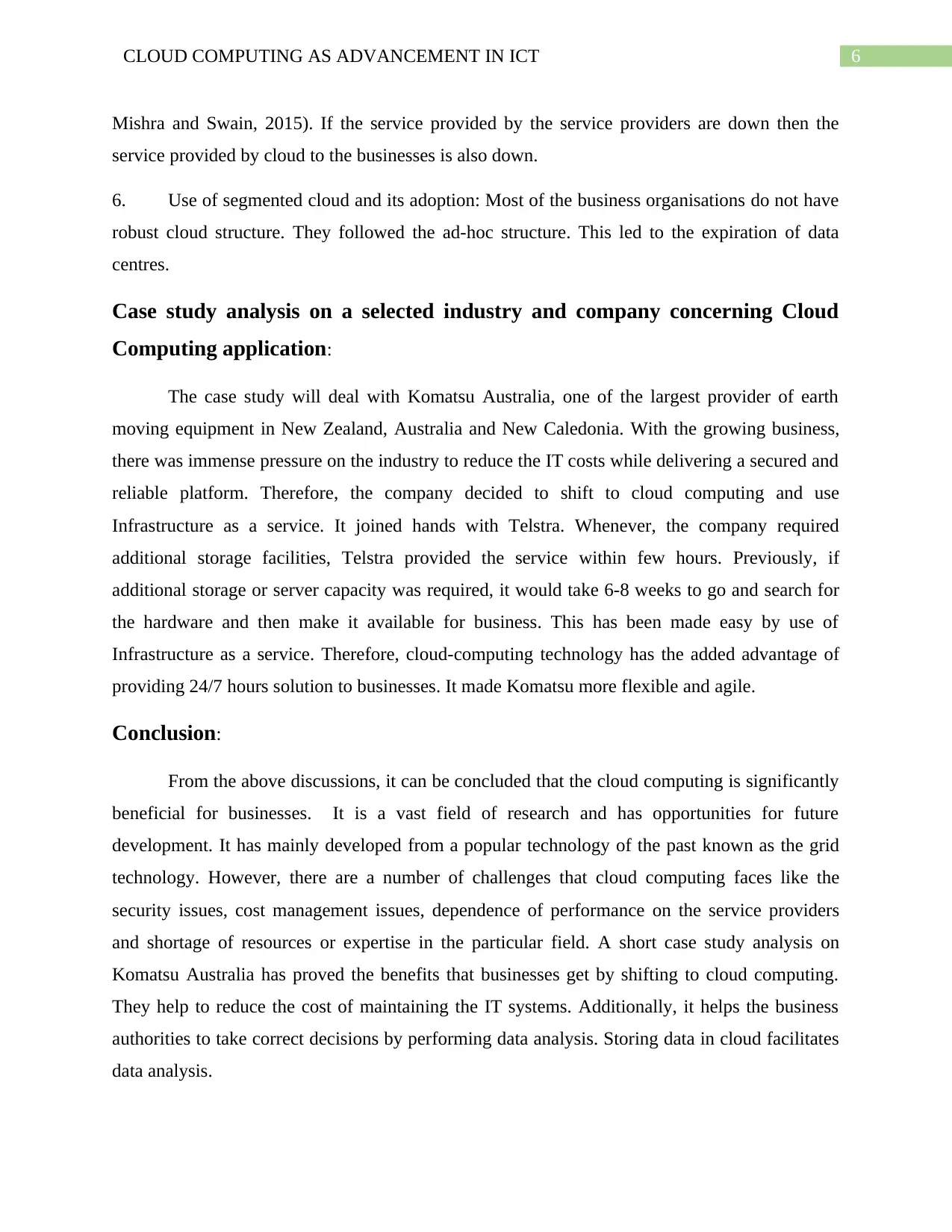
6CLOUD COMPUTING AS ADVANCEMENT IN ICT
Mishra and Swain, 2015). If the service provided by the service providers are down then the
service provided by cloud to the businesses is also down.
6. Use of segmented cloud and its adoption: Most of the business organisations do not have
robust cloud structure. They followed the ad-hoc structure. This led to the expiration of data
centres.
Case study analysis on a selected industry and company concerning Cloud
Computing application:
The case study will deal with Komatsu Australia, one of the largest provider of earth
moving equipment in New Zealand, Australia and New Caledonia. With the growing business,
there was immense pressure on the industry to reduce the IT costs while delivering a secured and
reliable platform. Therefore, the company decided to shift to cloud computing and use
Infrastructure as a service. It joined hands with Telstra. Whenever, the company required
additional storage facilities, Telstra provided the service within few hours. Previously, if
additional storage or server capacity was required, it would take 6-8 weeks to go and search for
the hardware and then make it available for business. This has been made easy by use of
Infrastructure as a service. Therefore, cloud-computing technology has the added advantage of
providing 24/7 hours solution to businesses. It made Komatsu more flexible and agile.
Conclusion:
From the above discussions, it can be concluded that the cloud computing is significantly
beneficial for businesses. It is a vast field of research and has opportunities for future
development. It has mainly developed from a popular technology of the past known as the grid
technology. However, there are a number of challenges that cloud computing faces like the
security issues, cost management issues, dependence of performance on the service providers
and shortage of resources or expertise in the particular field. A short case study analysis on
Komatsu Australia has proved the benefits that businesses get by shifting to cloud computing.
They help to reduce the cost of maintaining the IT systems. Additionally, it helps the business
authorities to take correct decisions by performing data analysis. Storing data in cloud facilitates
data analysis.
Mishra and Swain, 2015). If the service provided by the service providers are down then the
service provided by cloud to the businesses is also down.
6. Use of segmented cloud and its adoption: Most of the business organisations do not have
robust cloud structure. They followed the ad-hoc structure. This led to the expiration of data
centres.
Case study analysis on a selected industry and company concerning Cloud
Computing application:
The case study will deal with Komatsu Australia, one of the largest provider of earth
moving equipment in New Zealand, Australia and New Caledonia. With the growing business,
there was immense pressure on the industry to reduce the IT costs while delivering a secured and
reliable platform. Therefore, the company decided to shift to cloud computing and use
Infrastructure as a service. It joined hands with Telstra. Whenever, the company required
additional storage facilities, Telstra provided the service within few hours. Previously, if
additional storage or server capacity was required, it would take 6-8 weeks to go and search for
the hardware and then make it available for business. This has been made easy by use of
Infrastructure as a service. Therefore, cloud-computing technology has the added advantage of
providing 24/7 hours solution to businesses. It made Komatsu more flexible and agile.
Conclusion:
From the above discussions, it can be concluded that the cloud computing is significantly
beneficial for businesses. It is a vast field of research and has opportunities for future
development. It has mainly developed from a popular technology of the past known as the grid
technology. However, there are a number of challenges that cloud computing faces like the
security issues, cost management issues, dependence of performance on the service providers
and shortage of resources or expertise in the particular field. A short case study analysis on
Komatsu Australia has proved the benefits that businesses get by shifting to cloud computing.
They help to reduce the cost of maintaining the IT systems. Additionally, it helps the business
authorities to take correct decisions by performing data analysis. Storing data in cloud facilitates
data analysis.
Paraphrase This Document
Need a fresh take? Get an instant paraphrase of this document with our AI Paraphraser
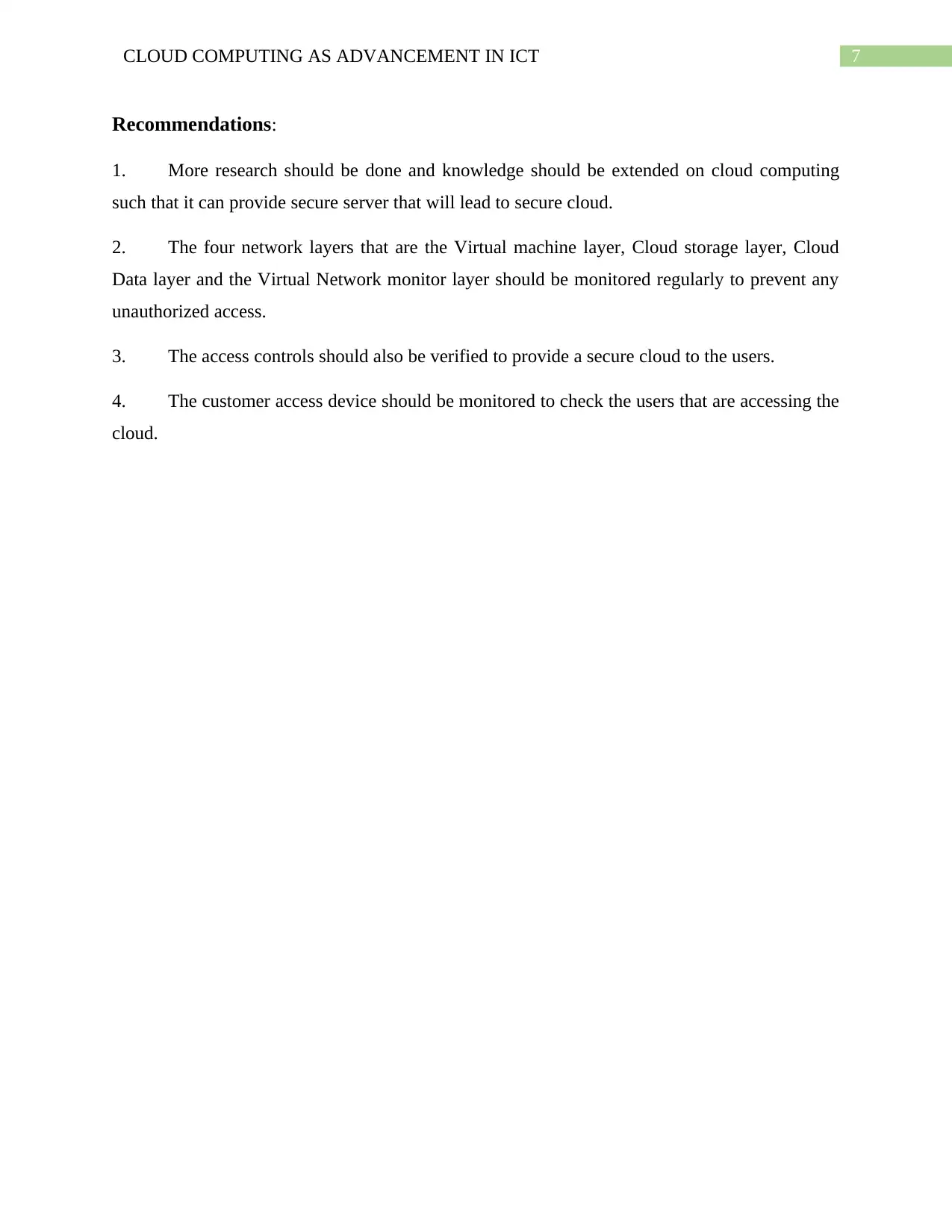
7CLOUD COMPUTING AS ADVANCEMENT IN ICT
Recommendations:
1. More research should be done and knowledge should be extended on cloud computing
such that it can provide secure server that will lead to secure cloud.
2. The four network layers that are the Virtual machine layer, Cloud storage layer, Cloud
Data layer and the Virtual Network monitor layer should be monitored regularly to prevent any
unauthorized access.
3. The access controls should also be verified to provide a secure cloud to the users.
4. The customer access device should be monitored to check the users that are accessing the
cloud.
Recommendations:
1. More research should be done and knowledge should be extended on cloud computing
such that it can provide secure server that will lead to secure cloud.
2. The four network layers that are the Virtual machine layer, Cloud storage layer, Cloud
Data layer and the Virtual Network monitor layer should be monitored regularly to prevent any
unauthorized access.
3. The access controls should also be verified to provide a secure cloud to the users.
4. The customer access device should be monitored to check the users that are accessing the
cloud.
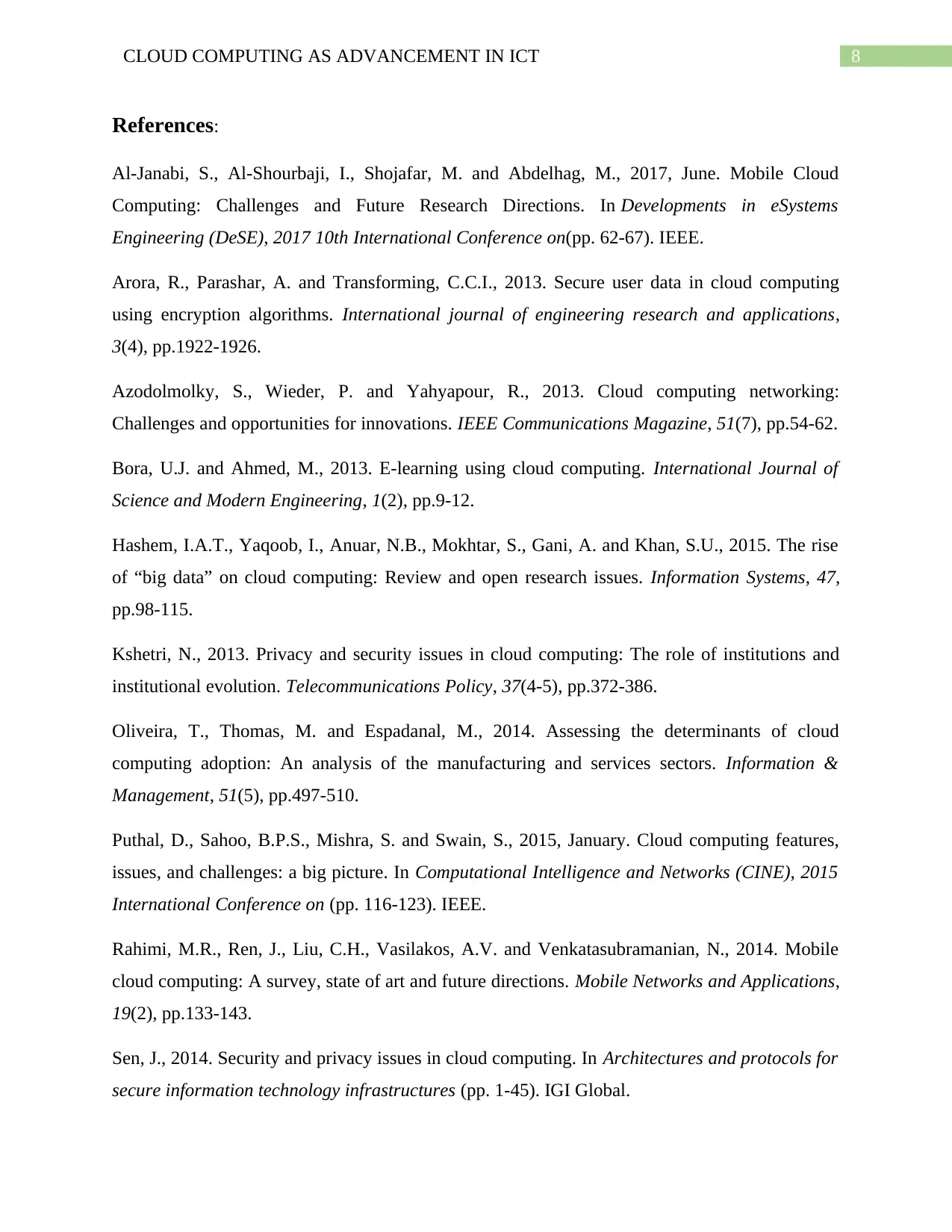
8CLOUD COMPUTING AS ADVANCEMENT IN ICT
References:
Al-Janabi, S., Al-Shourbaji, I., Shojafar, M. and Abdelhag, M., 2017, June. Mobile Cloud
Computing: Challenges and Future Research Directions. In Developments in eSystems
Engineering (DeSE), 2017 10th International Conference on(pp. 62-67). IEEE.
Arora, R., Parashar, A. and Transforming, C.C.I., 2013. Secure user data in cloud computing
using encryption algorithms. International journal of engineering research and applications,
3(4), pp.1922-1926.
Azodolmolky, S., Wieder, P. and Yahyapour, R., 2013. Cloud computing networking:
Challenges and opportunities for innovations. IEEE Communications Magazine, 51(7), pp.54-62.
Bora, U.J. and Ahmed, M., 2013. E-learning using cloud computing. International Journal of
Science and Modern Engineering, 1(2), pp.9-12.
Hashem, I.A.T., Yaqoob, I., Anuar, N.B., Mokhtar, S., Gani, A. and Khan, S.U., 2015. The rise
of “big data” on cloud computing: Review and open research issues. Information Systems, 47,
pp.98-115.
Kshetri, N., 2013. Privacy and security issues in cloud computing: The role of institutions and
institutional evolution. Telecommunications Policy, 37(4-5), pp.372-386.
Oliveira, T., Thomas, M. and Espadanal, M., 2014. Assessing the determinants of cloud
computing adoption: An analysis of the manufacturing and services sectors. Information &
Management, 51(5), pp.497-510.
Puthal, D., Sahoo, B.P.S., Mishra, S. and Swain, S., 2015, January. Cloud computing features,
issues, and challenges: a big picture. In Computational Intelligence and Networks (CINE), 2015
International Conference on (pp. 116-123). IEEE.
Rahimi, M.R., Ren, J., Liu, C.H., Vasilakos, A.V. and Venkatasubramanian, N., 2014. Mobile
cloud computing: A survey, state of art and future directions. Mobile Networks and Applications,
19(2), pp.133-143.
Sen, J., 2014. Security and privacy issues in cloud computing. In Architectures and protocols for
secure information technology infrastructures (pp. 1-45). IGI Global.
References:
Al-Janabi, S., Al-Shourbaji, I., Shojafar, M. and Abdelhag, M., 2017, June. Mobile Cloud
Computing: Challenges and Future Research Directions. In Developments in eSystems
Engineering (DeSE), 2017 10th International Conference on(pp. 62-67). IEEE.
Arora, R., Parashar, A. and Transforming, C.C.I., 2013. Secure user data in cloud computing
using encryption algorithms. International journal of engineering research and applications,
3(4), pp.1922-1926.
Azodolmolky, S., Wieder, P. and Yahyapour, R., 2013. Cloud computing networking:
Challenges and opportunities for innovations. IEEE Communications Magazine, 51(7), pp.54-62.
Bora, U.J. and Ahmed, M., 2013. E-learning using cloud computing. International Journal of
Science and Modern Engineering, 1(2), pp.9-12.
Hashem, I.A.T., Yaqoob, I., Anuar, N.B., Mokhtar, S., Gani, A. and Khan, S.U., 2015. The rise
of “big data” on cloud computing: Review and open research issues. Information Systems, 47,
pp.98-115.
Kshetri, N., 2013. Privacy and security issues in cloud computing: The role of institutions and
institutional evolution. Telecommunications Policy, 37(4-5), pp.372-386.
Oliveira, T., Thomas, M. and Espadanal, M., 2014. Assessing the determinants of cloud
computing adoption: An analysis of the manufacturing and services sectors. Information &
Management, 51(5), pp.497-510.
Puthal, D., Sahoo, B.P.S., Mishra, S. and Swain, S., 2015, January. Cloud computing features,
issues, and challenges: a big picture. In Computational Intelligence and Networks (CINE), 2015
International Conference on (pp. 116-123). IEEE.
Rahimi, M.R., Ren, J., Liu, C.H., Vasilakos, A.V. and Venkatasubramanian, N., 2014. Mobile
cloud computing: A survey, state of art and future directions. Mobile Networks and Applications,
19(2), pp.133-143.
Sen, J., 2014. Security and privacy issues in cloud computing. In Architectures and protocols for
secure information technology infrastructures (pp. 1-45). IGI Global.
⊘ This is a preview!⊘
Do you want full access?
Subscribe today to unlock all pages.

Trusted by 1+ million students worldwide
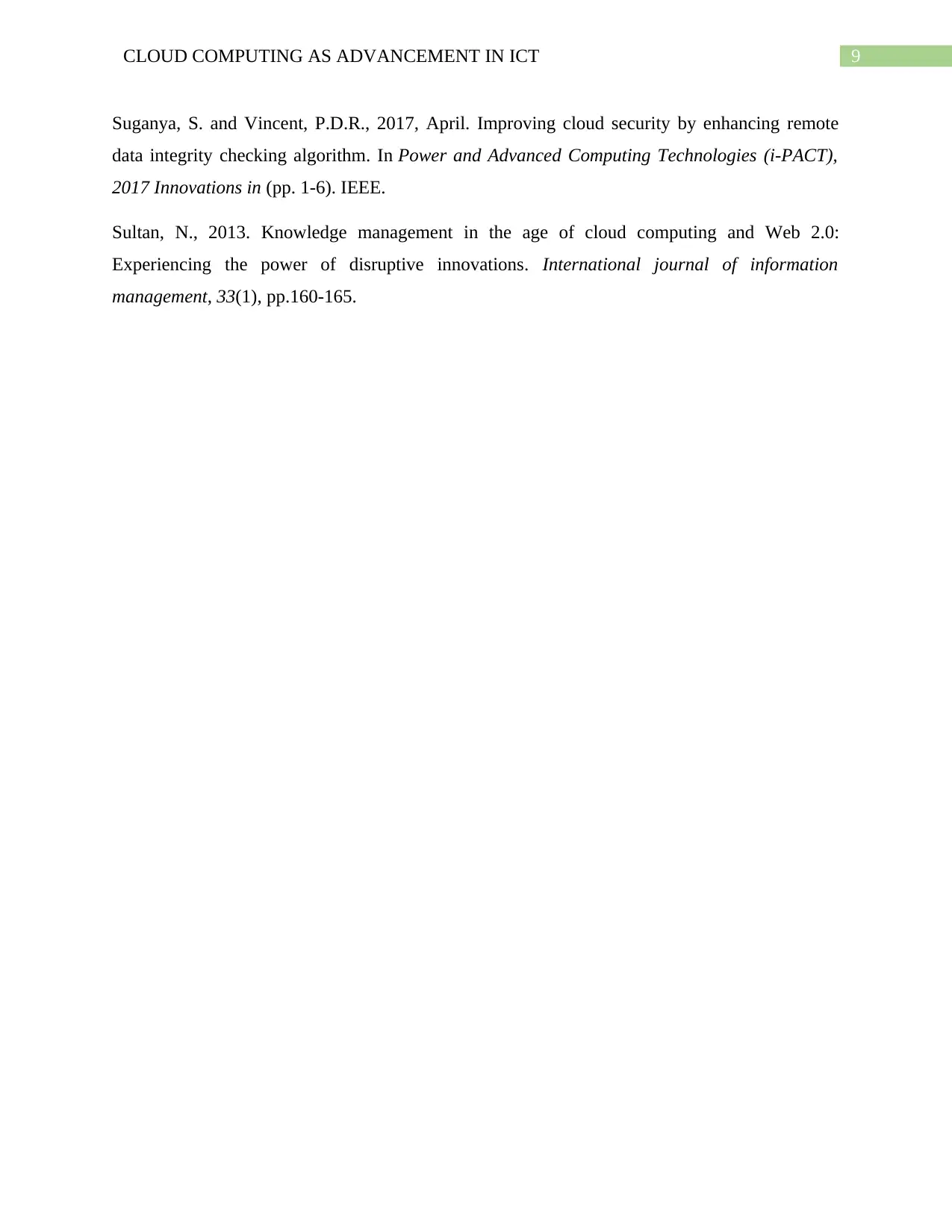
9CLOUD COMPUTING AS ADVANCEMENT IN ICT
Suganya, S. and Vincent, P.D.R., 2017, April. Improving cloud security by enhancing remote
data integrity checking algorithm. In Power and Advanced Computing Technologies (i-PACT),
2017 Innovations in (pp. 1-6). IEEE.
Sultan, N., 2013. Knowledge management in the age of cloud computing and Web 2.0:
Experiencing the power of disruptive innovations. International journal of information
management, 33(1), pp.160-165.
Suganya, S. and Vincent, P.D.R., 2017, April. Improving cloud security by enhancing remote
data integrity checking algorithm. In Power and Advanced Computing Technologies (i-PACT),
2017 Innovations in (pp. 1-6). IEEE.
Sultan, N., 2013. Knowledge management in the age of cloud computing and Web 2.0:
Experiencing the power of disruptive innovations. International journal of information
management, 33(1), pp.160-165.
1 out of 10
Related Documents
Your All-in-One AI-Powered Toolkit for Academic Success.
+13062052269
info@desklib.com
Available 24*7 on WhatsApp / Email
![[object Object]](/_next/static/media/star-bottom.7253800d.svg)
Unlock your academic potential
Copyright © 2020–2025 A2Z Services. All Rights Reserved. Developed and managed by ZUCOL.





